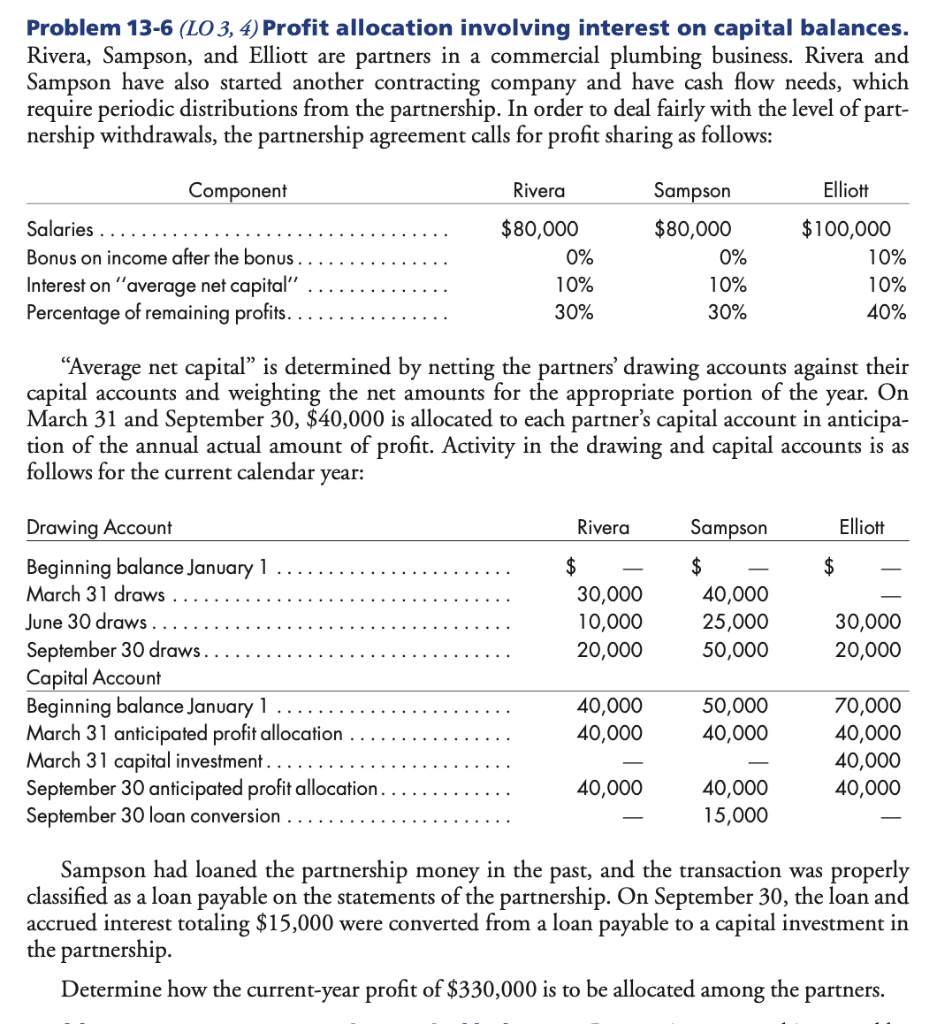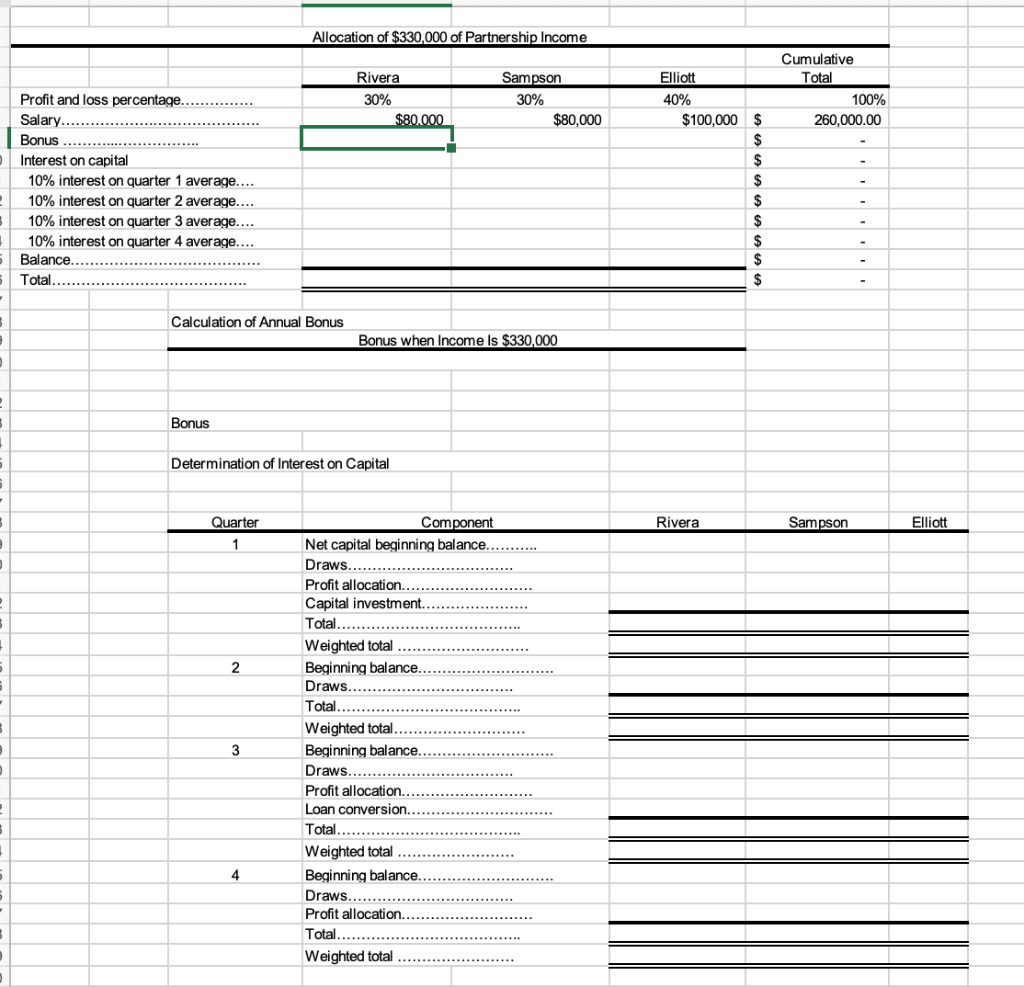Answered step by step
Verified Expert Solution
Question
1 Approved Answer
Answer the Question (top) using the template (bottom) Problem 13-6 (LO 3, 4) Profit allocation involving interest on capital balances. Rivera, Sampson, and Elliott are


Answer the Question (top) using the template (bottom)
Problem 13-6 (LO 3, 4) Profit allocation involving interest on capital balances. Rivera, Sampson, and Elliott are partners in a commercial plumbing business. Rivera and Sampson have also started another contracting company and have cash flow needs, which require periodic distributions from the partnership. In order to deal fairly with the level of part- nership withdrawals, the partnership agreement calls for profit sharing as follows: Rivera Elliott Component Salaries .. Bonus on income after the bonus Interest on "average net capital" Percentage of remaining profits. $80,000 0% 10% 30% Sampson $80,000 0% 10% 30% $100,000 10% 10% 40% Average net capital is determined by netting the partners' drawing accounts against their capital accounts and weighting the net amounts for the appropriate portion of the year. On March 31 and September 30, $40,000 is allocated to each partner's capital account in anticipa- tion of the annual actual amount of profit. Activity in the drawing and capital accounts is as follows for the current calendar year: Drawing Account Rivera Sampson Elliott $ $ 30,000 10,000 20,000 $ 40,000 25,000 50,000 30,000 20,000 Beginning balance January 1 March 31 draws . June 30 draws .. September 30 draws.. Capital Account Beginning balance January 1 March 31 anticipated profit allocation March 31 capital investment... September 30 anticipated profit allocation. September 30 loan conversion 40,000 40,000 50,000 40,000 70,000 40,000 40,000 40,000 40,000 40,000 15,000 Sampson had loaned the partnership money in the ast, and the transaction was properly classified as a loan payable on the statements of the partnership. On September 30, the loan and accrued interest totaling $15,000 were converted from a loan payable to a capital investment in the partnership Determine how the current-year profit of $330,000 is to be allocated among the partners. Allocation of $330,000 of Partnership Income Rivera 30% $80.000 Profit and loss percentage... Cumulative Total 100% 260,000.00 Sampson 30% $80,000 Salary Elliott 40% $100,000 $ $ $ $ $ Bonus Interest on capital 10% interest on quarter 1 average.... 10% interest on quarter 2 average.... 10% interest on quarter 3 average.... 10% interest on quarter 4 average.... Balance.. Total $ $ $ $ Calculation of Annual Bonus Bonus when Income is $330.000 Bonus Determination of Interest on Capital Quarter Rivera Sampson Elliott 1 2 Component Net capital beginning balance....... Draws. Profit allocation. Capital investment.. Total......... Weighted total Beginning balance. Draws. Total Weighted total. Beginning balance. Draws. Profit allocation. Loan conversion............ Total. Weighted total Beginning balance. Draws. Profit allocation. Total.. Weighted total 3 4 Problem 13-6 (LO 3, 4) Profit allocation involving interest on capital balances. Rivera, Sampson, and Elliott are partners in a commercial plumbing business. Rivera and Sampson have also started another contracting company and have cash flow needs, which require periodic distributions from the partnership. In order to deal fairly with the level of part- nership withdrawals, the partnership agreement calls for profit sharing as follows: Rivera Elliott Component Salaries .. Bonus on income after the bonus Interest on "average net capital" Percentage of remaining profits. $80,000 0% 10% 30% Sampson $80,000 0% 10% 30% $100,000 10% 10% 40% Average net capital is determined by netting the partners' drawing accounts against their capital accounts and weighting the net amounts for the appropriate portion of the year. On March 31 and September 30, $40,000 is allocated to each partner's capital account in anticipa- tion of the annual actual amount of profit. Activity in the drawing and capital accounts is as follows for the current calendar year: Drawing Account Rivera Sampson Elliott $ $ 30,000 10,000 20,000 $ 40,000 25,000 50,000 30,000 20,000 Beginning balance January 1 March 31 draws . June 30 draws .. September 30 draws.. Capital Account Beginning balance January 1 March 31 anticipated profit allocation March 31 capital investment... September 30 anticipated profit allocation. September 30 loan conversion 40,000 40,000 50,000 40,000 70,000 40,000 40,000 40,000 40,000 40,000 15,000 Sampson had loaned the partnership money in the ast, and the transaction was properly classified as a loan payable on the statements of the partnership. On September 30, the loan and accrued interest totaling $15,000 were converted from a loan payable to a capital investment in the partnership Determine how the current-year profit of $330,000 is to be allocated among the partners. Allocation of $330,000 of Partnership Income Rivera 30% $80.000 Profit and loss percentage... Cumulative Total 100% 260,000.00 Sampson 30% $80,000 Salary Elliott 40% $100,000 $ $ $ $ $ Bonus Interest on capital 10% interest on quarter 1 average.... 10% interest on quarter 2 average.... 10% interest on quarter 3 average.... 10% interest on quarter 4 average.... Balance.. Total $ $ $ $ Calculation of Annual Bonus Bonus when Income is $330.000 Bonus Determination of Interest on Capital Quarter Rivera Sampson Elliott 1 2 Component Net capital beginning balance....... Draws. Profit allocation. Capital investment.. Total......... Weighted total Beginning balance. Draws. Total Weighted total. Beginning balance. Draws. Profit allocation. Loan conversion............ Total. Weighted total Beginning balance. Draws. Profit allocation. Total.. Weighted total 3 4Step by Step Solution
There are 3 Steps involved in it
Step: 1

Get Instant Access to Expert-Tailored Solutions
See step-by-step solutions with expert insights and AI powered tools for academic success
Step: 2

Step: 3

Ace Your Homework with AI
Get the answers you need in no time with our AI-driven, step-by-step assistance
Get Started


